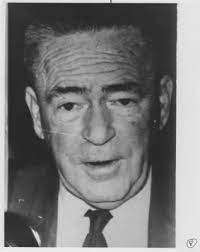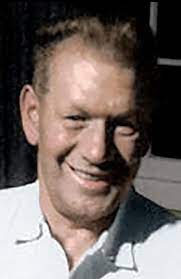by Charles Lear, author of “The Flying Saucer Investigators.”
 Throughout the history of flying saucers/UFOs, there have been characters that those being kind would describe as “colorful,” and those being blunt would describe as liars, hoaxers and con men. One of these characters was Fred Crisman, who became famous/infamous due to his involvement in the Maury Island case. Crisman was accused of hoaxing the case along with his business partner, Harold Dahl, and the two confessed as much to an FBI agent who investigated (page 20 of pdf) due to the deaths of two military intelligence officers associated with the case. Crisman faded from the public eye after this but showed up again on November 21, 1968 when he was called to testify at the trial of Clay Shaw looking into the JFK assassination. We have recently come across some correspondence between a UFO investigator, Crisman, and Dahl in the pages of a 1967 edition of a British UFO magazine that may be of interest to our readers.
Throughout the history of flying saucers/UFOs, there have been characters that those being kind would describe as “colorful,” and those being blunt would describe as liars, hoaxers and con men. One of these characters was Fred Crisman, who became famous/infamous due to his involvement in the Maury Island case. Crisman was accused of hoaxing the case along with his business partner, Harold Dahl, and the two confessed as much to an FBI agent who investigated (page 20 of pdf) due to the deaths of two military intelligence officers associated with the case. Crisman faded from the public eye after this but showed up again on November 21, 1968 when he was called to testify at the trial of Clay Shaw looking into the JFK assassination. We have recently come across some correspondence between a UFO investigator, Crisman, and Dahl in the pages of a 1967 edition of a British UFO magazine that may be of interest to our readers.
Crisman seemed to be compelled to insert himself into the middle of a mystery. In 1946, he wrote a letter to Amazing Stories Editor Ray Palmer, who had just brought the magazine a great deal of success with his promotion of the Shaver Mystery. This got its name from stories written by Richard Shaver about underground-dwelling-ne’er-do-wells called “deros” who influenced us up here on the surface with mind-control rays. Shaver seemed to believe they were based on truth, and Palmer might have as well, but he definitely promoted them as such. Crisman’s letter (page 178 of the pdf) was published in the June 1946 issue and it tells of Crisman and a buddy fighting deros in a cave in Burma. According to Crisman, his buddy got a dime-sized hole in his bicep from a dero raygun.
Crisman wrote another letter to Palmer in 1947, just after the Kenneth Arnold sighting in June of that year had kicked off the whole flying disk craze. Crisman told Palmer that, on Maury Island, just off the coast of Tacoma, Washington, he had recovered some material from a disk. Palmer had been in communication with Arnold regarding his sighting and arranged for him to fly (Arnold was a private pilot) to Tacoma and look into the story. Palmer wired him $200 for his troubles and Arnold became the world’s first privately funded flying saucer investigator.
The story that came out was that Dahl, while in a boat belonging to him and Crisman had seen six doughnut-shaped saucers near Maury Island. One of them seemed to be having problems, and it dumped hot debris that broke Dahl’s son’s arm and killed his dog.
Arnold found himself unsure of what to believe and called in the military intelligence officers who looked into his case, Lt. Frank M. Brown and Capt. William Davidson. They weren’t impressed and left, but not before Crisman insisted they take some of the debris with them, which he handed to them in a cornflakes box. Their plane crashed, killing both of them, and the headline the next day in the August 2, 1947 Tacoma Times was “Sabotage Hinted in Crash of Army Bomber at Kelso: Plane may Hold Flying Disc Secret.” Brown and Davidson’s names appeared in the story before they were released to the press and the person most likely to have given the information to the paper was Crisman.
 Harold Dahl kept a low profile after that, but Crisman would occasionally speak as a lecturer on flying saucers and started hosting a political radio show on August 1, 1968, for which he used the alias Jon Gold. On July 23, 1967, at a UFO convention in Seattle, Washington, Unidentified Aerial Phenomena Research Organization Director Gary Lesley met Crisman, and Crisman gave him Dahl’s address. This led to a series of letters between the three of them that were published in the January-February 1969 Merseyside UFO Buletin (page 6 of the pdf).
Harold Dahl kept a low profile after that, but Crisman would occasionally speak as a lecturer on flying saucers and started hosting a political radio show on August 1, 1968, for which he used the alias Jon Gold. On July 23, 1967, at a UFO convention in Seattle, Washington, Unidentified Aerial Phenomena Research Organization Director Gary Lesley met Crisman, and Crisman gave him Dahl’s address. This led to a series of letters between the three of them that were published in the January-February 1969 Merseyside UFO Buletin (page 6 of the pdf).
Lesley wrote a letter to Dahl the next day asking if he could help him in getting the facts straight regarding the Maury Island case. He asked if Dahl would: send him copies of the photos (Crisman had told Arnold that he’d taken photos of the craft that appeared when he went to investigate, but he never produced them), send him a “written testimony of the account as you remember it,” and contact “Dr.” Crisman (Crisman hadn’t given him his address) and get a written testimony from him. Finally, he asked if the boat was intact or if the damage from the raining debris was still visible.
Lesley got a letter back from Dahl dated August 22, 1967. He informs Lesley that it has been his and Crisman’s “policy” not to answer letters regarding the Maury Island incident. He complains about the treatment he, and particularly Crisman, received at the hands of a disbelieving public. He mentions, however, that with renewed interest in the case, the public might not be “quite so ready to laugh and call me (us) insane.”
According to Dahl, after Maury Island, Crisman “returned to the Air Force to fight in Korea and finish his schooling after that as a psychologist.” He mentions a television show starring Ray Thinnes called The Invaders that he swears is based on Crisman’s life. He describes Crisman as a “serious investigator” who has “never” sought publicity, and “has never used his knowledge of the saucer thing for personal gain…” and that he had contempt for those who did so.
That being said, he wrote that he didn’t know why Crisman was speaking in Seattle and that when he asked Crisman, Crisman replied that it was better he didn’t “know all the facts.” He mentions that Crisman was scheduled to speak with “a Dr. Frank Stranges” in Omaha, Nebraska, and New York, but that Crisman didn’t show up.
Dahl describes Crisman as “probably the most learned individual in this country in the general knowledge of UFOs,” and “one of the few men – that have studied the files of project Blue Book.” According to him, “something changed for Lee” after the Maury Island incident, and he had seen less and less of him over the years.
Lesley describes 7 lines of the next paragraph as being “obliterated as if by a censor.” Dahl answered his questions saying he could “allow” Lesley to have copies of the photos, and that he would give him a written account only after Crisman approved it. He said he sent Lesley’s address to Crisman in New Orleans but that if Lesley receives an answer “it will be a very big change in his usual attitude.” He said he’d get a statement from his son that Crisman would also have to approve, that the boat was “still intact” and was sold years ago, and that the damage was repaired, but they had pictures of it.
Researchers have looked into Crisman’s life and the Crisman they found doesn’t quite match up with the Crisman presented by Dahl. Adam Gorightly summed up Crisman’s life and exploits as Part 003 of his series “The Raymond Broshears Files” headlined “Flying Saucer Attack!”
After summing up the Maury Island incident, he describes Crisman, using cited sources, as being called back to active duty during the Korean War in 1951. He was assigned as a P-51 fighter pilot. Gorightly cites researcher Mike Sylwester as coming up with the information that Crisman had premonitions that he would be killed and got himself reassigned as a transport pilot. He continued to suffer anxiety to the point where he was hospitalized in Japan and, quoting Sylwester, “began to abuse tranquilizers during this period.”
Crisman left the military in 1953 and became a high school teacher in Elgin, Oregon, and a school superintendent in Huntington, Oregon. In 1958, he was arrested and charged with drunk driving and disorderly conduct, and it was found that he was under the influence of barbiturates. Because of this, he was fired from his job with the school system. According to Sylwester, Crisman made strange statements to the police, including saying that he had a metal plate in his head.
That same year, Crisman became acquainted with Frank Stranges and Wayne Aho, two saucer lecturers who could also be described as “colorful.” “Dr.” Frank Stranges wrote a 1967 book Stranger at the Pentagon in which he claimed to have met a Venusian, Valiant Thor, who was offering advice to the Eisenhower administration. Aho was a contactee who founded the “Church of the New Age” and was involved with two saucer swindlers, Otis T. Carr and Reinholdt Schmidt, both of whom were convicted for saucer-related criminal activity. Carr had claimed to have built a working flying saucer that he and Aho were supposed to pilot, but a demonstration failed. Aho was brought up on charges along with Carr, but it was determined that he was just a dupe.Amazing Stories Cover
As for Crisman using the title “Dr.,” and Dahl writing that Crisman had finished his education in psychology after the war, there seems to be an explanation. According to the Wikipedia entry on Crisman, citing the November 6, 1966 Washington Olympian as the source, “In November 1966, Crisman founded The Professional Research Bureau, with T. Edward Beckham and Searoba Bates, seeking ‘to conduct research and consultation within the fields of peology research and industrial psychology, public relations and criminology.’” Gorightly explains that Crisman and Stranges “ran a number of dicey diploma mills” so they perhaps bestowed the title of “Dr.” on each other.
Next week: Letters from Crisman.